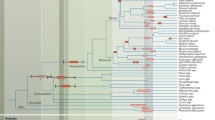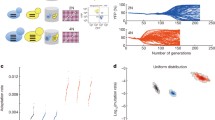Conclusion
In general, then, genetic evidence from polyploids harmonizes surprisingly well with concepts based on the modern gene-chromosome law of heredity. This is true for both the individual hereditary characters and the organism as a whole. With the former, it is evident that character inheritance follows the particular gene distribution even when the cytological mechanism is disturbed by the addition of chromosomes.
The organism as a whole is also influenced by polyploidy but the relations of the parts are, nevertheless, maintained. The addition of one chromosome in a trisomic, for example, alters many individual characters and upsets the favorable balance of plus and minus factors established in the diploid by long continued selection. Nevertheless, the plant continues to function as a whole. This can mean only that there is a high degree of elasticity in an organism, affording a margin of safety for variable conditions. This may well explain the success of the mutation theory of evolution in giving new mutations time to become established and to become fitted into the germinal complex in which they arose. True polyploidy affords, in addition, extra gene loci as sources for new mutations. Such extra loci, as they mutate, must preserve a correlated function with their original sister loci and the polyploid condition would seem to afford time and protection for this process.
Similar content being viewed by others
Literature
Allen, C. E. Polyploidy inSphaerocarpus. Proc. 6th Int. Congr. Genetics2: 1–2. 1932.
Bartlett, M. S. andHaldane, J. B. S. The theory of inbreeding in autotetraploids. Jour. Genetics29: 175–180. 1934.
Beatus, Richard. Genetik und Chiasmatypie bei Polyploiden. Der Biologe4: 1–11. 1935.
Belling, John andBlakeslee, A. F. The distribution of chromo-somes in tetraploidDatura. Am. Nat.58: 60–70. 1924.
——. The reduction division in haploid, diploid, triploid and tetraploidDaturas. Proc. Nat. Acad. Sci.9: 106–111. 1923.
Blakeslee, A. F. Types of mutations and their possible significance in evolution Am. Nat.55: 254–267. 1921.
— andSinnott, E. W. Structural changes associated with factor mutations and with chromosome mutations inDatura. Proc. Nat. Acad. Sci.8: 17–19. 1922.
— andFarnham, M. E. Trisomie inheritance in the Poin-settia mutant ofDatura. Am. Nat.57: 481–495. 1923.
—,Belling, J. andFarnham, M. E. Inheritance of tetra-ploidDatura. Bot. Gaz.76: 329–373. 1923.
Brink, R. A. Cytogenetic evolutionary processes in plants. Am. Nat.69: 97–124. 1935.
Clausen, R. E. andGoodspeed, T. H. Interspecific hybridization inNicotiana. II. A tetraploidglutinosa-tabacum hybrid, an experi-mental verification of Winge’s hypothesis. Genetics10: 278–284. 1925.
——. Inheritance inNicotiana tabacum. The tri-somie character, “enlarged.” Genetics9: 181–197. 1924.
Collins, G. N. andLongley, A. E. A tetraploid hybrid of maize and perennial teosinte. Jour. Agr. Res.50: 123–133. 1935.
Crane, M. B. andDarlington, C. D. Chromatid segregation in tetraploidRubus. Nature129: 869. 1932.
Darlington, C. R. Recent advances in cytology. 1932.
—. Meiosis in diploid and tetraploidPrimula sinensis. Jour. Genetics24: 65–96. 1931.
Emerson, R. A. Genetic notes on hybrids of perennial Teosinte and maize. Am. Nat.63: 289–300. 1929.
— andBeadle, G. W. A fertile tetraploid hybrid betweenEuchlaena perennis andZea mays. Am. Nat.64: 190–192. 1930.
Fernandes, A. Nouvelles études caryologiques sur le genreNarcissus L. Bol. Soc. Broteriana11: 1–198. 1934.
Gregory, R. P. On the genetics of tetraploid plants inPrimula sinensis. Proc. Roy. Soc. B.87: 484–492. 1914.
Haldane, J. B. S. Theoretical genetics of autopolyploids. Jour. Genetics22: 359–372. 1930.
Humphrey, L. M. The meiotic divisions of haploid, diploid and tetra-ploid tomatoes with special reference to the prophase. Cytologia5: 278–300. 1934.
Huskins, C. L. The origin ofSpartina Townsendii. Genetica12: 531–538. 1930.
Jorgensen, C. A. The experimental formation of heteroploid plants in the genusSolatium. Jour. Genetics19: 133–211. 1928.
Karpechenko, G. D. The production of polyploid gametes in hybrids. Hereditas9: 349–308. 1927.
—. Polyploid hybrids ofRaphanus sativus L ×Brassica oleracea L. Zeits. Induk. Abst. Vererb.48: 1–85. 1928.
Lawrence, W. J. C. The genetics and cytology ofDahlia variabilis. Jour. Genetics24: 257–306. 1931.
Lesley, J. W. A cytological and genetical study of progenies of triploid tomatoes. Genetics13: 1–43. 1928.
— andMann, M. C. Triploidy in the tomato. Science61: 208. 1925.
—. The genetics ofLycopersicum esculentum Mill. I. The trisomic inheritance of “dwarf.” Genetics11: 352–354. 1926.
Lindstrom, E. W. andKoos, Katharine. Cyto-genetic investigations of a haploid tomato and its diploid and tetraploid progeny. Am. Jour. Bot.18: 398–410. 1931.
— andHumphrey, L. M. Comparative cyto-genetic studies of tetraploid tomatoes from different origins. Genetics18: 193–200. 1933.
Longley, A. E. Chromosomes in grass sorghums. Jour. Agr. Res.44: 317–321. 1932.
McClintock, Barbara. A cytological and genetical study of triploid maize. Genetics14: 180–182. 1929.
Muller, H. J. A new mode of segregation in Gregory’s tetraploidPrimulas. Am. Nat.48: 508–512. 1914.
Müntzing, Arne. Cytogenetic investigations on syntheticGaleopsis tetrahit. Hereditas16: 105–154. 1932.
Newton, W. C. F. and Pellew, Caroline.Primula Kewensis and its derivatives. Jour. Genetics20: 405–467. 1929.
— andDarlington, C. D. Meiosis in polyploids. I. Jour. Genetics21: 1–15. 1929.
Pellew, Caroline andDurham, F. The genetic behavior of the hybridPrimula Kewensis and its allies. Jour. Genetics5: 157. 1916.
Randolph, L. F. Cytogenetics of tetraploid maize. Jour. Agr. Res.50: 591–605. 1935.
Rhoades, Marcus M. An experimental and theoretical study of chro-matid crossing øver. Genetics18: 535–555. 1933.
— andMcClintock, Barbara. The cytogenetics of maize. Bot. Rev.1: 292–325. 1935.
Rohweder, H. Beiträge zur Systematik and Phylogenie des GenusDianthus. Bot. Jahrb. Systematik66: 249–366. 1934.
Sansome, F. W. Chromatid segregation inSolanum lycopersicum. Jour. Genetics27: 105–132. 1933.
-and Philp, J. Recent advances in plant genetics. 1932.
Sharp, L. W. Introduction to cytology. 1934.
Sinnort, E. W., Houghtaling, Helen and Blakeslee, A. F. The comparative anatomy of extra-chromosomal types inDatura stramonium. Carnegie Inst. Wash. Pub. 451. 1934.
Skovsted, A. Cytological investigations of the genusAesculus L. Hereditas12: 64–70. 1929.
Sömme, A. Sverdrup. Genetics and cytology of the tetraploid form ofPrimula sinensis. Jour. Genetics23: 447–509. 1930.
Wanscher, J. H. The basic chromosome number of the higher plants. New Phyt.33: 101–126. 1934.
Wettstein, F. v. Morphologie und Physiologie des Fonnwechsels der Moose auf genetischer Grundlage. I. Zeits. Induk. Abst. Vererb.33: 1–236. 1924.
—. Morphologie und Physiologie des Formwechsels der Moose auf genetischer Grundlage. II. Bibliotheca Genetica10: 1–216. 1928.
Winkler, H. Über die experimentelle Erzeugung von Pflanzen mit abweichenden Chromosomenzahlen. Zeits. Bot.8: 417–544. 1916.
de Winton, D. andHaldane, J. B. S. Linkage in the tetraploidPrimula sinensis. Jour. Genetics24: 121–144. 1931.
Author information
Authors and Affiliations
Additional information
Paper No. 70, Department of Genetics, Iowa State College, Ames, Iowa.
Rights and permissions
About this article
Cite this article
Lindstrom, E.W. Genetics of polyploidy. Bot. Rev 2, 197–215 (1936). https://doi.org/10.1007/BF02872444
Issue Date:
DOI: https://doi.org/10.1007/BF02872444




